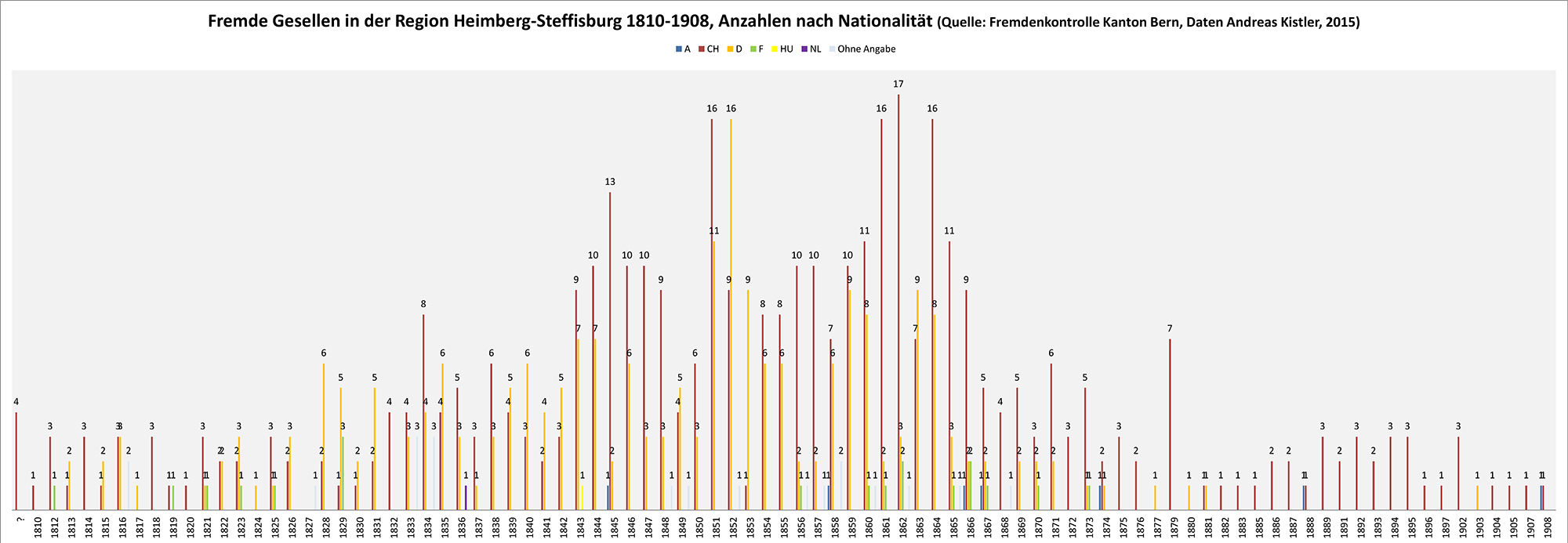
Places of pottery production in the Canton of Bern based on archival sources.
Andreas Kistler, Andreas Heege, 2021
Thanks to its statutory system of registering foreign (non-Bernese) citizens, the Canton of Bern now has a unique source from which to glean information about migrating tradespeople. While the lists from some offices have not survived, the preserved records do, nevertheless, provide basic information on 19th century pottery making in the Canton of Bern. From 1810 to 1908, every journeyman hailing from another canton or country had to be registered; the information that had to be provided included the journeyman’s place of work, the name of the potter who was going to employ them, how long they were going to work there, and their own name and place of origin. As a result, we now have a list of 19th century potteries (green dots in the map) that were sufficiently profitable to allow for journeymen to be hired. The list also gives an impression of what cantons or where in Austria, Germany or (very rarely) France the journeymen came from. In the 19th century, migrant journeymen were the driving force behind the technological and decorative changes that took place in pottery making and played a considerable part in the formation and spread of “Heimberg type” pottery or “Thun majolica”.
List of potters in the Canton of Bern employing foreign journeymen (data provided by Andreas Kistler based on the records in the Bern State Archive)
Alphabetical list of foreign journeymen (data provided by Andreas Kistler based on the records in the Bern State Archive)
List of foreign journeymen sorted by country, canton/state, place (data provided by Andreas Kistler based on the records in the Bern State Archive)
The influx of both Swiss and German journeymen to Heimberg continued unabated after 1800. For the period between 1810 and 1908, the archival sources include 401 journeymen from Switzerland (incl. Canton of Bern), 229 from Germany, 19 from France (Alsace), 7 from Austria and one each from the Netherlands and Hungary registered as working in the two relevant districts of Thun and Konolfingen (Bern State Archive, registry of foreign citizens).

The vast majority of journeymen from Germany came from Baden and Württemberg, with much smaller numbers hailing from Bavaria, Hessen, Nassau, Prussia and Saxony. Many of the Swiss journeymen originated from the Cantons of Aargau (mainly Rekingen), Basel (Läufelfingen), Lucerne (Malters, Meggen), St Gallen (Berneck and places around Altstätten, Au, Balgach, Eichberg, Lüchingen, Marbach as well as Rapperswil, St Gallen), Schaffhausen (Beggingen, Neunkirch, Oberhallau, Unterhallau, Thayngen and Wilchingen), Thurgau (Berlingen, Steckborn), Vaud (Duillier, Poliez-Pittet) and Zurich (Bülach, Dällikon, Rafz, Schauenberg, Unterstammheim, Wädenswil and Zurich). They all brought what they had learned from making “Heimberg style” pottery (decorative techniques and motifs) back to their home cantons and states, thus ensuring the spread of this type of pottery.
If we assume that the records kept by the different registration offices were correct, there were never more than 27 foreign journeymen working in the region around Heimberg-Steffisburg in any of the years between 1809 and 1908, contrary to what was stated by Schwab 1921, 85: “80 journeymen each year in the 1850s”. This would mean that an additional 50 journeymen from the Canton of Bern would have been employed in the region at the same time. In their most productive years between 1843 and 1866, the Heimberg workshops recorded more than 10 new registrations every year. After 1866, the numbers fell below ten and between 1880 and 1908 there were only between one and three foreign registrations each year. The conflicts between the Swiss and German journeymen mentioned by Schwab 1921, 81 for the 1860s are clearly supported by the records. While nine German journeymen were registered in the Heimberg region in 1863 and eight in 1864, that number fell to three in 1865, two in 1866, one in 1867, and none in 1868. Eleven German journeymen in total were registered between 1869 and 1881. It must be borne in mind, however, that the Heimberg pottery trade appears to have experienced a period of crisis and underwent a phase of reorganisation at that time and as a consequence the number of Swiss journeymen also decreased significantly.
Translation Sandy Haemmerle
German: Geselle
French: Compagnons
References:
Schwab 1921
Fernand Schwab, Beitrag zur Geschichte der bernischen Geschirrindustrie (Schweizer Industrie- und Handelsstudien 7), Weinfelden/Konstanz 1921.

